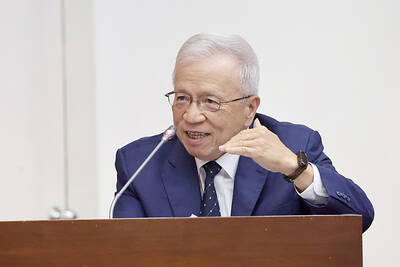E Ink Holdings Inc (元太科技), the world’s No. 1 e-paper display maker, yesterday said operating income spiked 76 percent last quarter, thanks to strong demand for e-readers such as the Kindle from online bookstore operator Amazon.
Operating income surged to NT$1.13 billion (US$35.5 million) in the second quarter, compared with NT$644 million in the first quarter, after gross margin rose to set an all-time high of 39.6 percent. Gross margin stood at 29.7 percent in the first three months of the year.
Rising shipments of better-price e-paper displays and high-end flat panels used in Apple Inc’s iPad tablet device were major factors behind its strong growth in operating income, E Ink Holdings said. The firm did not disclose shipment figures.
Net income, however, fell slightly by 0.6 percent at a quarterly rate to NT$700 million during the period from April to June from the first quarter’s NT$704 million, which included a one-off of NT$300 million in royalties charges, primarily from South Korean LCD panel maker LG Display Co.
A year ago, E Ink lost NT$955 million.
“We are very satisfied with the growth of e-reader sales ... Amazon’s new Kindle is outfitted with our new-generation Pearl e-paper display and supply could become tight as pre-sales are excellent,” company chairman Scott Liu (劉思誠) told investors.
That, to some extent, countered concerns about iPad’s erosion of consumer support for e-readers, said Liu, adding that the Kindle and the iPad were two distinct devices in terms of features and targeted users.
E Ink commands more than 90 percent of the e-paper display market around the world.
Good uptake of e-readers and a rising share in high-margin products, such as high-end LCD panels made on key technology from its South Korean unit Hydis Technology Co, have helped push the higher gross margin, Liu said.
Hydis had swung into profit in April after switching its products to e-paper displays and high-end LCD panels, he said.
Looking ahead, Liu said revenues would pick up this month, leading to growth of between 40 percent and 50 percent in the second half of the year, compared with NT$10.18 billion made in the first half, on the back of the US holiday shopping season.
Sixty-five percent of the company’s revenue came from e-paper displays and it has not seen substantial progress by rivals.
Liu said his company was ready with colored e-paper displays and he expected China’s e-reader maker Hanvon Technology Co (漢王科技) to become the first company using the displays.
Sales of global e-readers are expected to double to 20 million units next year as retail price has fallen to less than US$200 plus contract service, Liu said.
Shares of E Ink plunged 2.92 percent to NT$46.6, under-performing the benchmark TAIEX, which slid 0.72 percent yesterday.

JITTERS: Nexperia has a 20 percent market share for chips powering simpler features such as window controls, and changing supply chains could take years European carmakers are looking into ways to scratch components made with parts from China, spooked by deepening geopolitical spats playing out through chipmaker Nexperia BV and Beijing’s export controls on rare earths. To protect operations from trade ructions, several automakers are pushing major suppliers to find permanent alternatives to Chinese semiconductors, people familiar with the matter said. The industry is considering broader changes to its supply chain to adapt to shifting geopolitics, Europe’s main suppliers lobby CLEPA head Matthias Zink said. “We had some indications already — questions like: ‘How can you supply me without this dependency on China?’” Zink, who also

At least US$50 million for the freedom of an Emirati sheikh: That is the king’s ransom paid two weeks ago to militants linked to al-Qaeda who are pushing to topple the Malian government and impose Islamic law. Alongside a crippling fuel blockade, the Group for the Support of Islam and Muslims (JNIM) has made kidnapping wealthy foreigners for a ransom a pillar of its strategy of “economic jihad.” Its goal: Oust the junta, which has struggled to contain Mali’s decade-long insurgency since taking power following back-to-back coups in 2020 and 2021, by scaring away investors and paralyzing the west African country’s economy.

Taiwan Semiconductor Manufacturing Co (TSMC, 台積電) received about NT$147 billion (US$4.71 billion) in subsidies from the US, Japanese, German and Chinese governments over the past two years for its global expansion. Financial data compiled by the world’s largest contract chipmaker showed the company secured NT$4.77 billion in subsidies from the governments in the third quarter, bringing the total for the first three quarters of the year to about NT$71.9 billion. Along with the NT$75.16 billion in financial aid TSMC received last year, the chipmaker obtained NT$147 billion in subsidies in almost two years, the data showed. The subsidies received by its subsidiaries —

BUST FEARS: While a KMT legislator asked if an AI bubble could affect Taiwan, the DGBAS minister said the sector appears on track to continue growing The local property market has cooled down moderately following a series of credit control measures designed to contain speculation, the central bank said yesterday, while remaining tight-lipped about potential rule relaxations. Lawmakers in a meeting of the legislature’s Finance Committee voiced concerns to central bank officials that the credit control measures have adversely affected the government’s tax income and small and medium-sized property developers, with limited positive effects. Housing prices have been climbing since 2016, even when the central bank imposed its first set of control measures in 2020, Chinese Nationalist Party (KMT) Legislator Lo Ting-wei (羅廷瑋) said. “Since the second half of